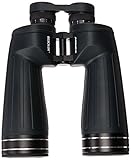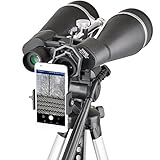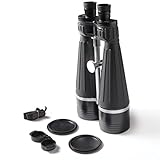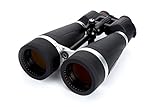10 Best Binoculars For Astronomy of December 2025
List of Top Rated Binoculars For Astronomy from thousands of customer reviews & feedback.
Updated On Dec 2025
2,736 Reviews Studied

- Multi coated optics
- Large aperture perfect for low light conditions and stargazing
- Tripod adapter 13 millimeter (0.51 inch) long eye relief ideal for eyeglass wearers; Linear Field of View (@1000 yards) / @1000 meter) 231 feet (77 meter)
- Diopter adjustment for fine focusing; Angular field of view 4.4 degrees
- Large 70 millimeter objective lens offers maximum image brightness in low light and long range conditions

- Giant Binoculars:13-39X zoom magnification and 70mm fully multi-coated objective offer great brightness and higher-contrast images in low-light and long-range conditions, which has higher-contrast images and reduces color errors and distortions.
- Astronomy Binoculars with smartphone adapter and Tripod Adapter:Phone adapter with rubber sucker, which can 180°angle and length adjustment,is easy to set up and take images. Tripod adapter for steady, hands-free viewing.
- With the easy-to-reach control knob on your left hand,it’s more convenient and quick to change the magnification from 13X-39X. Right diopter ring can be adjusted to meet different visions requirements between two eyes.
- Long eye relief is also ideal for eyeglass wearers.288ft field of view at 1000 yards offers you a wider field of view. Easier to observe fast moving objects.This zoom binocular offers you a new feeling of viewing experience.
- Binoculars astronomical:Long range binoculars with 13X-39X magnification is designed for long distance terrestrial and astronomical viewing. Perfect for moon star bird watching. It's good gifts for adults on Father's Day,birthday or Christmas.

- Big 20-power astronomy binoculars with huge 80mm aperture objective lenses provides bright, high-contrast views of the night sky with sharp resolution
- Giant 80mm lenses gobble up light for spectacular views of the Moon, planets, star clusters, and more!
- Fully multi-coated optics and BAK 4 porro prisms ensure maximum light throughput for bright, clear views
- Long 17mm eye relief for comfortable views - even while wearing eyeglasses!
- Includes built-in tripod adapter, soft carry case, and dust caps. Tripod use recommended

- 15-power astronomical binoculars with a rugged housing provide high-resolution views with a pleasing flat-field
- Fully waterproof and nitrogen purged construction prevents lens fogging
- High-quality BAK-4 prisms and advanced multi-coatings on all optical surfaces provide maximum light throughput for bright views rich in contrast
- The high-power 15x70 Resolux binoculars have a nice 4.4-degree field of view for big views
- Attachment to a tripod with the included tripod adapter is recommended for extended use

- Specially designed for Bird Watching, Sightseeing, Shooting and Star Gazing.
- OUTSTANDING OPTICS — Large Bak-4 Roof Prisms and fully Multi-coated 80mm large lens — guarentee the key elements of an optical device, and make your view brighter, clearer and delivers crisp images.
- EXTREMELY LARGE AND COMFORTABLE VIEW — Not like spotting scopes or telescopes, just look through the binoculars with you two eagle eyes open.
- DURABLE ALUMINUM POLYCARBONATE FRAMEWORK AND RUBBER ARMOR — for improved ergonomics protection from every day use in the field.
- COMES WITH PROTECTIVE SHIELD AND CARRYING CASE — Keeps the binoculars secure. Guard your binoculars against everything from dust to damage. Bonus simple protective shield - protects the binoculars from dust and moisture when it is on a tripod. It also helps block out stray light outside the path of the binoculars for better viewing.

- Giant 100mm objective lenses for deep-space bino-astronomy use
- Fully multi-coated lenses, rugged Metal construction and waterproof and nitrogen-purged
- BaK4 prisms provide excellent light transmission
- Individual eyepiece focus for the Most precise adjustments
- Accepts standard, 1.25-Inch Astronomical Filters over the eyepieces

- Large 80 mm objective lenses for excellent light gathering in low light conditions or for astronomical observing
- Detachable RSR rail for attaching an optional red dot finderscope
- Rubber armored for improved ergonomics and protection from every day use in the field
- Waterproof and nitrogen purged for use in all weather conditions

- POWERFUL 20X MAGNIFICATION: With our enhanced SkyMaster 20x80, you get massive 80mm objective lenses, This SkyMaster is ideal for those who love astronomy binoculars.
- INCLUDES TRIPOD ADAPTER: As an additional convenience to your sky-watching activities, our 80mm SkyMaster powerful binoculars include an integrated photo tripod adapter for easy hands-free use and portability.
- BRIGHT, SHARP VIEWING AND BaK-4 PRISMS: The SkyMaster is a favorite among those who view in dim conditions near dawn and dusk or for astronomy purposes. BaK-4 prisms deliver excellent light transmission for brighter and sharper image quality.
- DURABLE AND WATER-RESISTANT: A rugged, armored body provides protection and secure gripping surface, ensuring product durability for years to come. Its water-resistant exterior means you wont have to worry about getting caught in unexpected rainy weather
- UNBEATABLE WARRANTY AND CUSTOMER SUPPORT: Buy with confidence from the world’s #1 telescope brand, based in California since 1960. You’ll also receive a two-year warranty and unlimited access to technical support from our team of US-based experts.

- Wide field of view reveals a larger portion of the night sky, allowing you to view more of the comet's impressive tail
- Large 50 mm objective lenses have tremendous light gathering ability, ideal for astronomical use
- Multi coated optics dramatically increase light transmission for brighter images with increased contrast and resolution
- Large exit pupil provides maximum light during nighttime and low light viewing sessions
- Strong and durable alumnium housing
- Wide field of view reveals a larger portion of the night sky, allowing you to view more of the comet's impressive tail ^Large 50mm objective lenses have tremendous light-gathering ability, ideal for astronomical use ^Multi-coated optics dramatically increase light transmission for brighter images with increased contrast and resolution ^Large exit pupil provides maximum light during nighttime and low-light viewing sessions ^Strong and durable alumnium housing

- MULTI-COATED OPTICS AND BaK-4 PRISMS: Multi-coated optics help obtain high resolution and high contrast views, while the prisms made of BaK-4 glass will give you enhanced color fidelity. Enjoy crisp, detailed views and dependable performance with our Outland X all-around binocular
- WATERPROOF AND FOGPROOF: Designed to withstand all weather conditions, our Outland X compact binoculars have been filled and sealed with dry nitrogen gas for rigorous outdoor use without internal fogging of the lenses
- PROTECTIVE RUBBER COVERING: Our binocular is both durable and well-armored; its rugged exterior ensures protection from all outdoor elements while providing a secure, anti-slip gripping surface. The Outland X is also a great birdwatching binocular
- TWIST-UP EYECUPS FOR QUICK ADJUSTMENT: Large focus knobs make for easy and precise focusing, and twist-up eyecups allow for quick adjustment of eye relief to obtain a full field of view. Eyecups can be easily positioned for use with or without eyeglasses
- UNBEATABLE WARRANTY AND CUSTOMER SUPPORT: Buy with confidence from the world’s #1 telescope brand and a leading sport optics manufacturer, based in California since 1960. You’ll also receive a Limited Lifetime warranty and unlimited access to technical support from our team of US-based experts.
Binoculars for Astronomy: Purchasing Tips, Features, and Types
If you're a budding astronomer or just enjoy star gazing on a clear night, then you may want to invest in a pair of good binoculars. Although they are not as powerful as telescopes, binoculars allow more mobility and convenience. This buying guide will explore the different types of binoculars available for purchase, along with their pros and cons. We'll also give some tips on choosing the right pair based on your needs. So if you're ready to get out under that endless sky full of stars waiting there for you to be discovered, read this buying guide.
What are Binoculars For Astronomy?
Binoculars are a valuable tool for astronomy. Astronomy binoculars are designed to be lightweight, have large apertures and wide fields of view. You can also check other useful binoculars like Night Vision Binoculars which will improve your experience. Because you will likely have your hands full while viewing through the lens, the binoculars for astronomy should also include features that make them easy to maneuver. They are available in both monocular and binocular forms.
Types Of Binoculars For Astronomy
There are three types of binoculars that are typically used for astronomy:
Refractor Binoculars
These binoculars use a lens to collect light and form an image. This type is the most popular choice for astronomy because they offer clear, bright images.
Reflector Binoculars
These binoculars use mirrors to collect light and form an image. They are not as popular as refractor binoculars, but they have some advantages, such as being less expensive and having a larger field of view. If you are looking for affordable binoculars, opt for the Best Binoculars Under 500, which will fit your pocket and provide good results.
Catadioptric Binoculars
These binoculars use a combination of lenses and mirrors to form an image. They offer the best image quality of the three types but are also the most expensive.
Things To Consider While Purchasing Binoculars For Astronomy
Type
The type of binoculars you choose will depend on what you are looking to use them for. If you want the best image quality, catadioptric binoculars are often the best choice. These types of binoculars use both lenses and mirrors for their image-forming process, which means they can provide high contrast images with less ghosting than other types of binoculars.
Magnification
The magnification level is another consideration when choosing astronomy binoculars. If astronomers want to study certain objects in more detail, they will need a higher magnification level. It is important to remember that increasing the magnification also improves the image's shake and blurriness.
Aperture
The aperture size is another important consideration when choosing binoculars for astronomy. The aperture size determines how much light the binoculars can collect and how bright the image will be. Larger apertures are generally better for astronomy, although they also tend to be more expensive.
Field of View
The field of view is also important when choosing binoculars for astronomy. This is the amount of sky that can be seen through the binoculars at one time. A wide field of view is better for astronomy, which you can find in the Best Binoculars For Stargazing because it allows you to see more at once, making the experience feel less like looking through a tube and more like actually being outside observing nature.
Conclusion
In conclusion, Binoculars For Astronomy are very useful for amateur astronomers. They provide an inexpensive way to view the moon, planets, and other objects in space without having to purchase your telescope or spend money on a pricey planetarium program. We hope this buying guide has been helpful and that you will enjoy using your new binoculars for astronomy.



